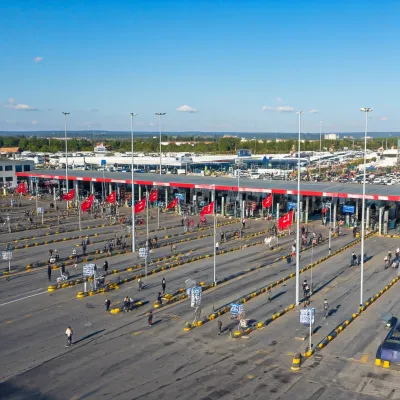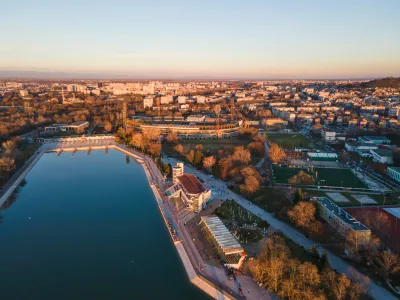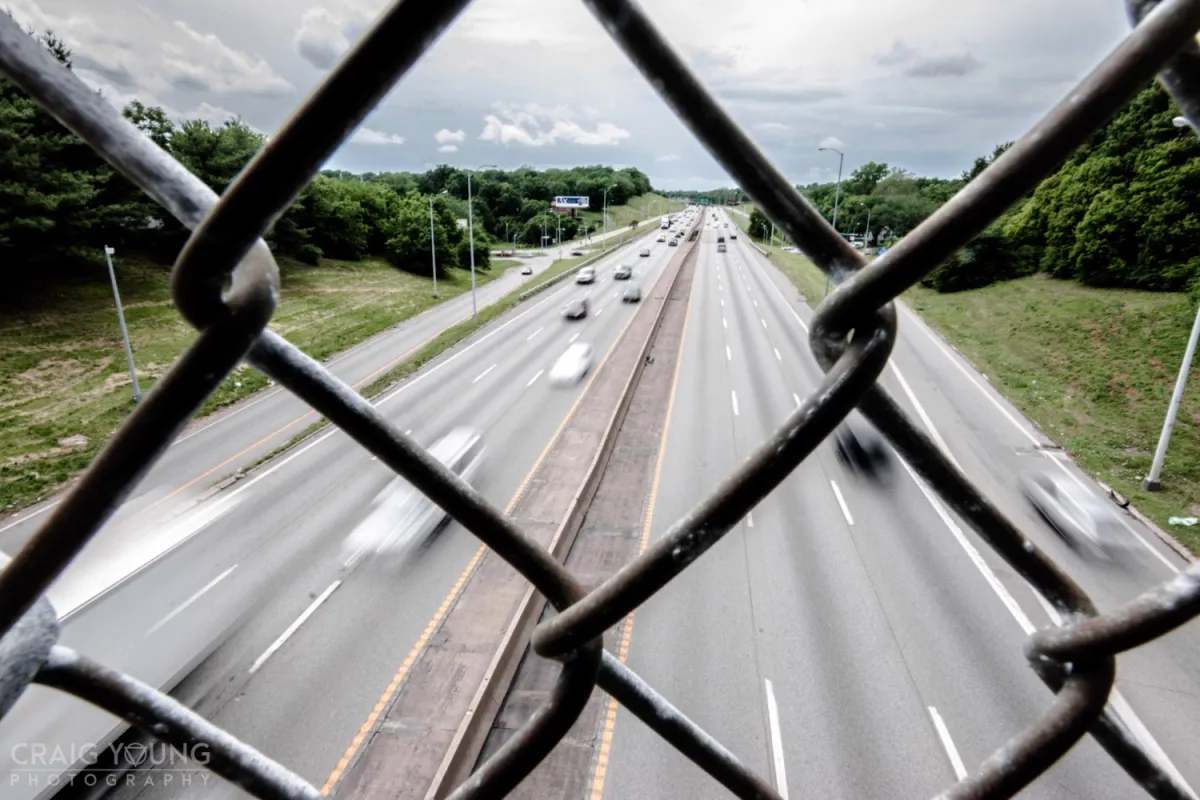

The Bulgaria-Turkey border is a critical transit route between Europe and Asia, facilitating trade, tourism, and cross-border travel. For travelers planning to navigate this border, here is an in-depth guide to the main crossing points, documentation, and travel tips:
Key Border Crossings:
The Bulgaria-Turkey border spans around 240 kilometers and features three major crossing points, each offering different advantages based on travel routes and destinations:
-
Kapitan Andreevo-Kapıkule:
- Location: Situated on the E80 European route, this crossing is the primary and busiest point between Bulgaria and Turkey, linking Sofia, Bulgaria, to Istanbul, Turkey.
- Traffic: It handles a significant volume of passenger vehicles, trucks, and buses, making it a crucial point for both tourists and commercial traffic.
- Facilities: The Kapitan Andreevo-Kapıkule crossing is well-equipped, offering services such as duty-free shops, restaurants, currency exchange, and vehicle inspection stations.
- Operating Hours: This crossing is open 24 hours a day, but long wait times can occur, especially during weekends, holidays, and the summer season.
- Ideal For: Travelers heading directly to Istanbul or the western parts of Turkey. It is the preferred crossing for those transporting goods due to its extensive facilities.
-
Lesovo-Hamzabeyli:
- Location: Located to the north of Kapitan Andreevo-Kapıkule, this crossing connects the Bulgarian town of Yambol with Edirne, Turkey.
- Traffic: While less crowded than Kapitan Andreevo-Kapıkule, it is increasingly popular among travelers looking to avoid heavy traffic.
- Facilities: The crossing offers basic amenities, including rest areas and customs offices. It is particularly used by smaller vehicles and regional traffic.
- Operating Hours: Open 24 hours a day, it serves as a viable alternative when the main crossing is too congested.
- Ideal For: Those looking for a quicker passage and willing to take a slightly longer route to reach Istanbul or other Turkish destinations.
-
Malko Tarnovo-Dereköy:
- Location: Situated in a more mountainous region to the east, this crossing links the Bulgarian town of Malko Tarnovo with Dereköy, Turkey.
- Traffic: The least busy of the three, it is ideal for those seeking a quieter and more scenic route.
- Facilities: The crossing has limited facilities, with fewer services than the other two, making it more suitable for passenger vehicles rather than trucks or buses.
- Operating Hours: Open 24/7, but it is important to check for any seasonal closures or restrictions due to weather conditions.
- Ideal For: Travelers interested in exploring the Strandzha Mountain region or visiting more rural parts of Turkey.
- Passport: All travelers, including EU citizens, need a valid passport to cross into Turkey. A visa may be required, depending on nationality. Turkey offers an e-Visa system that travelers can use to obtain their visa online before reaching the border.
- Vehicle Documents: Ensure you have your vehicle registration papers, a valid driver’s license, and proof of insurance (Green Card). Turkish customs may inspect these documents upon entry.
- Customs Declarations: Turkey has specific regulations regarding the importation of goods. Travelers should declare any goods exceeding personal use limits. It’s also important to be aware of restrictions on bringing in agricultural products, alcohol, and tobacco.
- Monitor Border Wait Times: Real-time updates on wait times are often available online or through apps, especially for the Kapitan Andreevo-Kapıkule crossing. Checking these before your trip can help you choose the best time to travel.
- Prepare for Inspections: At all crossings, customs and security checks are thorough, especially for those traveling with large vehicles or transporting goods. Be prepared for inspections of luggage and vehicles.
- Currency Exchange: While both Bulgarian lev (BGN) and Turkish lira (TRY) might be accepted near the border, it’s advisable to have some local currency for any immediate expenses, such as tolls, snacks, or fuel.
- Fuel Up: Fuel prices vary significantly between Bulgaria and Turkey. Many travelers choose to refuel in Bulgaria before crossing the border, as prices can be lower.
 For those looking to explore the areas near the border:
For those looking to explore the areas near the border:
- Bulgaria: Visit the city of Plovdiv, known for its rich history and Roman amphitheater, or explore the natural beauty of the Strandzha Nature Park near Malko Tarnovo.
- Turkey: Edirne, the first major city after crossing from Bulgaria, is home to the stunning Selimiye Mosque and vibrant local markets.
This guide provides essential information for a hassle-free journey across the Bulgaria-Turkey border, ensuring that travelers are well-prepared for the transition between Europe and Asia.
Spanning 513 km (319 mi), the Bulgaria-Turkey border serves as more than just a division between two nations—it is a vital link between Europe and the Middle East, holding both historical and strategic significance.
This guide aims to provide road users with essential information about crossing the border. It also explores the collaboration between Bulgaria and Turkey in maintaining the border and outlines plans for future developments.
Navigating the Bulgaria-Turkey Border: A Comprehensive Guide
For travelers journeying between Bulgaria and Turkey, this guide offers details about border crossings, access routes, and nearby attractions. It also highlights the cooperative efforts of both nations to facilitate smooth transit for trade and personal travel, alongside upcoming infrastructural projects.
The Bulgarian-Turkish Border: A Journey Through Time
The Bulgaria-Turkey land border is steeped in history, having been a crossroads of civilizations for centuries. This region has witnessed the ebb and flow of empires, fostering a rich cultural exchange and serving as a conduit for trade and migration.
In the present day, the shared border is a testament to strong cooperation between the two countries. Authorities from both sides work together in intelligence sharing, policing, and infrastructure development, ensuring security and connectivity.
Major Border Crossings and Must-See Attractions
Below is a detailed map of the key border crossing points between Bulgaria and Turkey:
- Kapitan Andreevo-Kapikule
- Lesovo-Hamzabeyli
- Malko Tarnovo-Dereköy
The busiest border crossing between Bulgaria and Turkey, situated southeast of Svilengrad and northwest of Edirne. It serves as a major gateway for both trade and tourism, accessible via the A4/E80 from Sofia (Bulgaria) and the D100/E80 from Istanbul (Turkey).
Edirne, a city rich in Ottoman history, invites visitors to explore landmarks like the Selimiye Mosque and the bustling Grand Bazaar, or to unwind along the Meriç (Maritsa) River. Travelers heading from Turkey into Bulgaria must obtain a Bulgarian vignette immediately upon crossing. Opting for a vignette with extended validity can be economical for those traveling round-trip to Western or Northern Europe.
This crossing is particularly popular among travelers from the Netherlands, Germany, and Austria, who use it when heading to Turkey for holidays. The highway from Edirne stretches to Dragoman, leading to Dimitrovgrad—a significant Serbian-Bulgarian border point.
To the northeast, this crossing provides a convenient transit point between the two countries. From Sofia, take Route I-7/E85 to reach Svilengrad and then continue to Lesovo. On the Turkish side, use the D535 from Edirne toward Uzunköprü and Hamzabeyli.
Edirne offers a treasure trove of cultural and historical sites, while the northern Arda River valley in Bulgaria showcases beautiful natural scenery. Nearby, the ancient city of Plovdiv is known for its exquisite wines and Roman architecture.
Nestled amid the stunning Strandzha Mountains, this crossing offers a scenic route between the two nations. From Malko Tarnovo in Bulgaria, take Road I-9 to reach the border, while in Turkey, the D-555/E87 leads from Dereköy to the border point.
Strandzha Nature Park is a highlight here, providing nature enthusiasts with breathtaking landscapes and diverse wildlife. Explore charming villages like Brashlyan in Bulgaria, or venture into the lush Dereköy forest in Turkey.
Navigating Border Procedures
As Turkey is not a member of the European Union or the Schengen Area, travelers from both countries, as well as EU citizens, need a valid passport or travel document. Following an inspection and passport stamping, access is granted. When departing Bulgarian territory, ensure you have a valid passport and a visa for Turkey, if required by your nationality.

The Bulgaria-Turkey border has become a critical point for asylum seekers, primarily from Middle Eastern countries, attempting to enter the European Union. Despite their efforts, many have been denied entry at this border, leading to increased tensions and controversies. Reports of mistreatment by police and border guards have surfaced, alongside opposition to the construction of a new border fence. The human rights commissioner of the Council of European Countries has voiced concerns directly to Bulgaria regarding these issues.
A river that delineates the border between Bulgaria, Greece, and Turkey has become a frequent crossing point for those seeking asylum. While it is not a common route for travel from Bulgaria to Greece, it is often used in the reverse direction. Many asylum seekers prefer this unofficial route to avoid detection at formal border crossings as they aim to reach Western Europe.
Some European Commission member states have supported the construction of a border fence, funded by the EU budget, to curb illegal immigration. As of December 2022, Austria has blocked Bulgaria's admission to the Schengen Area due to ongoing concerns related to border management. To date, 100 km of the planned 160 km border fence has been completed along Bulgaria’s border with Turkey.
Balancing Trade and Security: Measures for Smooth Transit at the Bulgaria-Turkey Border
Amidst challenges, the Bulgaria-Turkey border remains crucial for maintaining trade and economic cooperation between the two countries. Bulgaria's strategic location makes it a vital trade corridor connecting European countries with the Middle East and beyond.
To facilitate the smooth flow of goods, various measures have been implemented, including streamlined customs procedures and upgraded infrastructure. The deployment of modern technologies, alongside close collaboration between Bulgarian and Turkish authorities, ensures efficient and secure transit, preserving the flow of commerce across this critical gateway.
Investing in the Future: Upcoming Infrastructure Developments
A series of infrastructural upgrades are in the pipeline to further enhance trade, connectivity, and efficiency at the Bulgaria-Turkey border. Plans include modernizing key roads, adding new entry points, and introducing advanced technologies to expedite border procedures. These developments aim to improve the transit experience for travelers and traders alike.
The Bulgaria-Turkey border will continue to serve as a significant land bridge, fostering cultural exchange and economic ties between Europe, the Middle East, and beyond.
